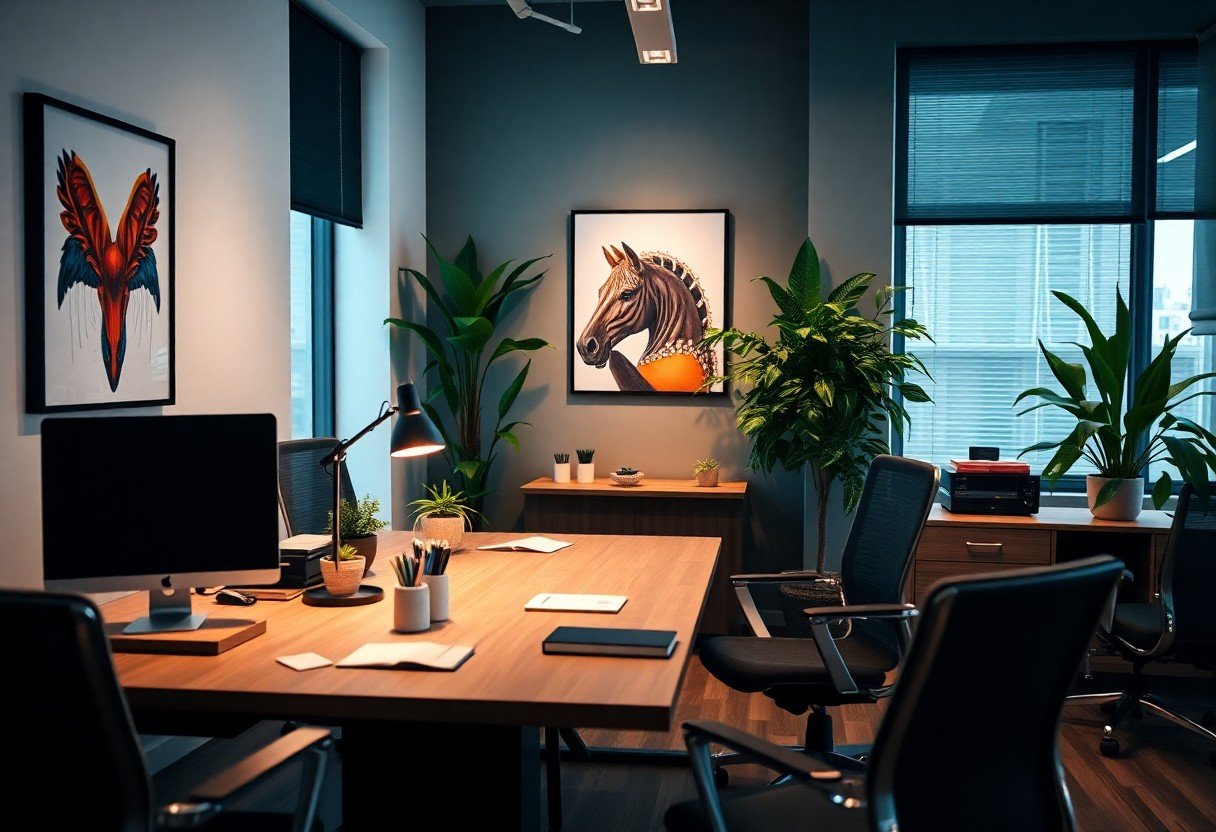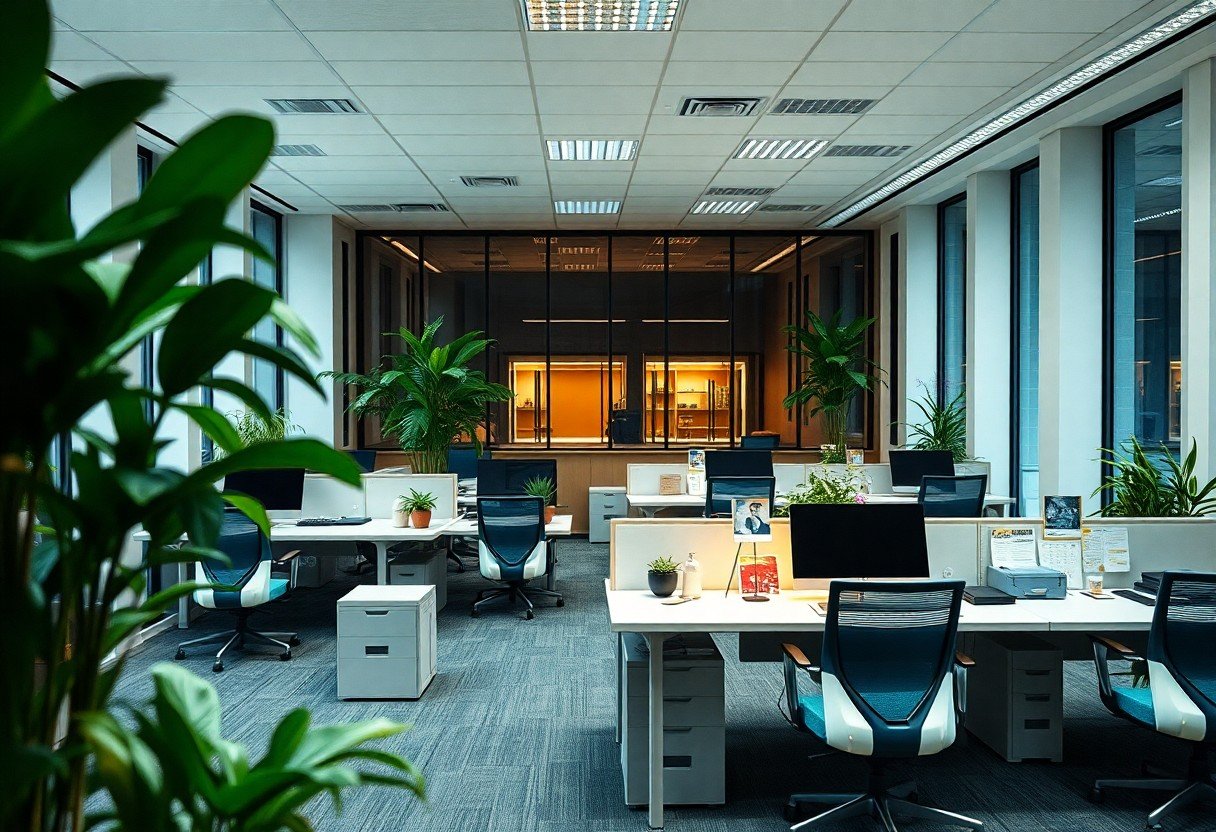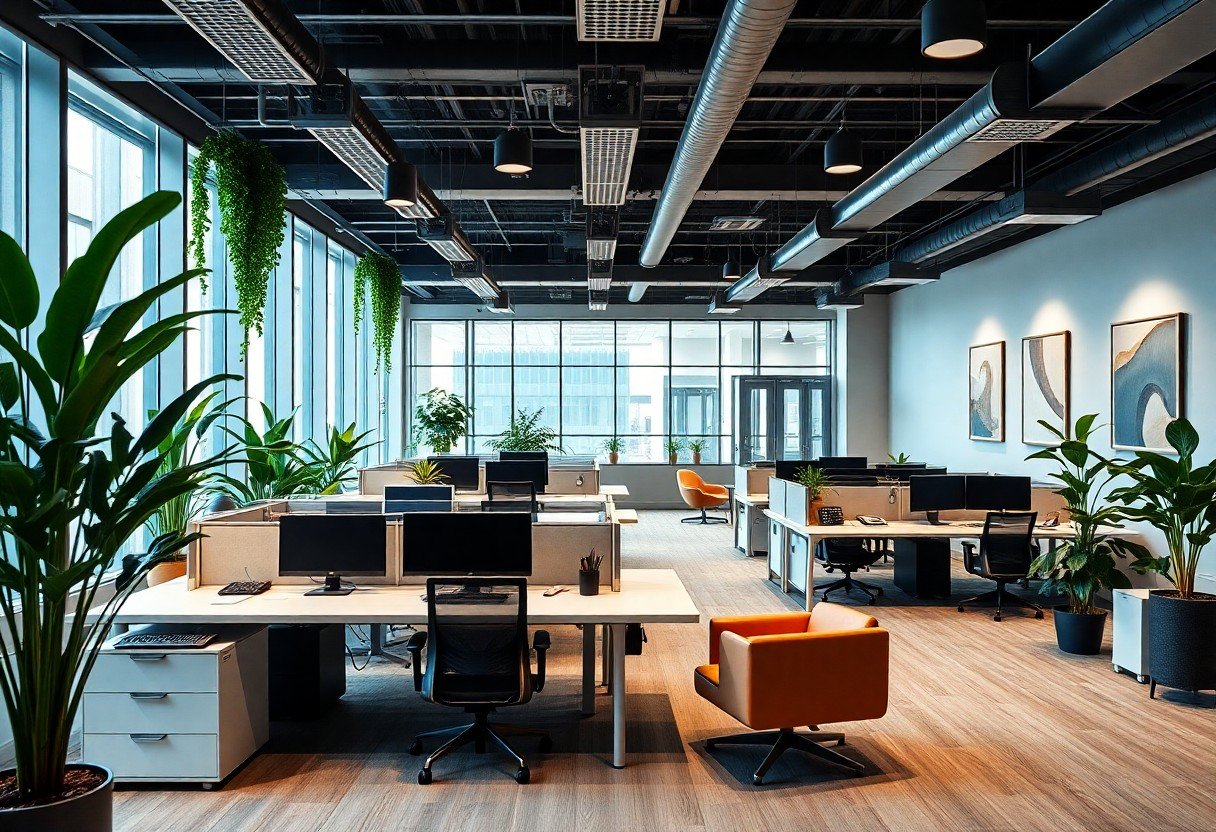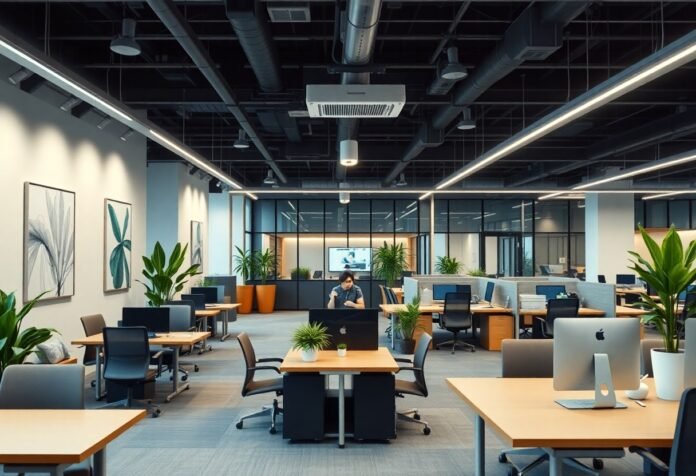Looking for the best Office Decor Ideas for Work 2025: Ideas for transforming your workspace in 2025 focus on blending functionality with style to boost productivity and well-being. By incorporating ergonomic furniture, smart lighting, and biophilic elements like indoor plants, you create a healthy environment that supports focus and creativity. Avoid clutter and harsh lighting, as these can negatively impact your mood and efficiency. Adopting these forward-thinking decor strategies not only enhances your workspace aesthetics but also promotes a balanced and inspiring atmosphere tailored to your needs.

Key Takeaways:
- Incorporate biophilic design elements such as indoor plants and natural lighting to enhance employee well-being and productivity.
- Opt for flexible and modular furniture that supports both collaborative work and individual focus, adapting to diverse work styles.
- Integrate smart technology like adjustable lighting, climate control, and wireless charging to create a more comfortable and efficient workspace.
Color Psychology: Setting the Right Tone
The Impact of Color on Mood and Productivity
Colors influence your brain in profound ways, affecting both your mood and productivity throughout the workday. Studies have demonstrated that blue tones promote calmness and concentration, making them ideal for environments that require sustained attention and problem-solving. Conversely, warm colors like oranges and reds can stimulate energy and creativity, though they might also increase stress levels if overused.
Incorporating green in your office decor has been linked to reduced eye strain and increased productivity, as it mimics nature and provides a refreshing visual break. Yet, using overly saturated or harsh color contrasts can lead to visual fatigue and decreased focus. Balancing these color effects according to your specific workflow needs will help you create a workspace that fosters both efficiency and emotional well-being.
Choosing Color Palettes for Inspiration and Focus
Selecting the right color palette involves more than picking trending hues; it means aligning colors with the type of work you want to inspire. Soft blues paired with muted yellows encourage clarity and innovation, often favored by creative teams. Meanwhile, neutral grays combined with strategic pops of vibrant colors like lime or coral inject energy without overwhelming the senses.
You might consider implementing color zoning—using different palettes in distinct zones of your office. This technique can signal various work modes, with calming palettes in quiet areas and stimulating palettes in collaborative zones. This approach maximizes the psychological benefits of color while accommodating diverse work styles in a shared environment.
Going deeper, the way you combine colors has a significant effect on their overall impact. Complementary colors can create visual harmony and balance, while analogous colors produce a more cohesive and soothing atmosphere. Experimenting with shades, tints, and saturation levels helps tailor your palette to fit the unique personality of your workspace, ensuring that each area supports your desired mood and productivity outcome effectively.
Nature-Inspired Designs: Bringing the Outdoors In
Integrating nature into your office design goes beyond aesthetic appeal—it fosters a workspace that stimulates all your senses. Tactile surfaces like stone accents or wooden desks create a tangible connection to the earth, inviting touch and familiarity. Moreover, incorporating water features such as small tabletop fountains can add an auditory element, producing soothing background sounds that help drown out office noise and elevate concentration.
Textures reminiscent of natural environments, from woven jute rugs to reclaimed wood cabinets, also contribute to a calming atmosphere. These elements, combined with earth tones and natural lighting, work collectively to create harmony in your space, making it easier for you to focus and feel connected even during the busiest workdays.
Biophilic Elements: Plants, Natural Light, and Organic Materials
Incorporating live plants is a straightforward way to bring biophilic principles into your office. Species like snake plants and pothos are particularly effective because they require minimal care and significantly improve indoor air quality by reducing pollutants. Positioning your workspace near windows allows sunlight to bathe your area, augmenting vitamin D synthesis and regulating your circadian rhythm—it’s been shown that workers exposed to natural light report up to 51% higher productivity levels.
Organic materials such as bamboo flooring, cork bulletin boards, or clay pots further enforce a natural aesthetic. These materials don’t just look good; they are often more sustainable and lend a warm texture that synthetic materials lack. Mixing these elements thoughtfully creates an environment that feels alive and inviting rather than sterile, encouraging you to remain energized and engaged throughout the day.
How Nature Fuels Creativity and Reduces Stress
Exposure to natural elements stimulates areas of the brain responsible for creativity and problem-solving, as demonstrated in a 2015 study where employees with nature views generated 15% more innovative ideas compared to those without. The presence of greenery and natural hues also triggers the parasympathetic nervous system, effectively lowering cortisol levels—the body’s primary stress hormone—and fostering a relaxed yet alert mental state.
Environments enriched with biophilic design tend to have lower absenteeism rates and increased job satisfaction. Companies like Amazon and Google have adopted these principles widely, noting measurable improvements in employee wellness and team collaboration as a direct result. Integrating nature into your office isn’t just a trend—it’s a scientifically backed strategy to heighten your creative capacity and mental well-being.
Studies consistently affirm that interaction with natural elements lowers heart rate and blood pressure, enhancing both cognitive function and emotional balance. Even brief daily exposure to plants and natural light can reduce fatigue and mental exhaustion, creating a more resilient workforce ready to tackle complex tasks. You can harness these benefits by curating a workspace where organic textures and green life form the backdrop for your daily endeavors, transforming work into a source of inspiration rather than strain.
Futuristic Furniture: Versatility Meets Ergonomics
Furniture in 2025 offices is transforming into multifunctional pieces designed not just for comfort but to accommodate various modes of working. Imagine desks equipped with embedded digital interfaces that easily switch from sitting to standing height at your voice command. These workstations don’t just enhance productivity—they adapt seamlessly to how you feel throughout the day and the task at hand, reducing strain without compromising style. Flexible chairs with adjustable lumbar support, temperature control, and even biometric monitoring are becoming standard, ensuring your office furniture works as hard on your comfort as you do on your projects.
These innovations not only contribute to a more dynamic work environment but also support sustainability goals. Many futuristic furniture lines incorporate recyclable materials and energy-efficient manufacturing processes. By selecting such pieces, your office becomes a hub of responsibility and forward-thinking design. As a result, your workspace reflects not just technological advancement, but also an intentional, healthy approach to everyday office life.
The Rise of Modular Workspaces: Adaptable Layouts for Dynamic Teams
Modular workspaces are revolutionizing how teams collaborate and transition between solo and group tasks. Components such as desks, storage units, and seating can be reconfigured within minutes without tools, allowing you to switch from private focus zones to open brainstorming hubs. This adaptability caters perfectly to hybrid work models where flexibility is vital, helping you optimize your space daily based on immediate needs.
By using lightweight partitions, sliding panels, and mobile furniture, you gain the ability to create customized work environments on the fly. For example, a small startup in Berlin reported a 30% increase in team productivity after implementing modular setups that employees could personalize themselves. The versatility supports creativity, improves communication flow, and fosters a sense of ownership over your office surroundings.
Ergonomic Innovations: Prioritizing Health and Well-Being
Health-focused designs now incorporate advances that go beyond adjustable chairs and desks. Smart ergonomic chairs with sensors track posture in real-time, gently nudging you through subtle vibrations or app notifications to sit correctly or take movement breaks. These chairs can even sync with wearable devices, giving you comprehensive feedback on your physical state during work hours. Integrations like these help reduce risks associated with prolonged sitting, such as chronic back pain or repetitive strain injuries.
Beyond furniture, office accessories like monitor arms that maintain optimal eye level and footrests designed to encourage natural circulation add further benefits. You might consider desks with built-in resistance bands or foot pedals promoting light physical activity to keep circulation flowing throughout the workday. This suite of ergonomic enhancements positions your workspace as a proactive environment designed to reduce fatigue and boost overall well-being.
Further developments in this area include AI-powered smart desks that adjust their height not only by your preference but by analyzing your activity patterns to promote movement rhythms scientifically linked to improved focus and reduced musculoskeletal disorders. As these products become increasingly accessible, you can expect your workspace to transform into a personalized wellness hub, integrating physical health seamlessly into your daily workflow.

Personalized Spaces: Reflecting Individuality at Work
Personalization within the workplace fosters a sense of ownership and comfort, allowing you to bring elements of your personality into your daily environment. Incorporating unique art pieces, meaningful photos, or custom desk accessories can make your workspace feel more inviting and tailored to your preferences. Companies like Google and Microsoft have demonstrated that employees perform better when they interact with spaces designed to resonate with their individual tastes and needs. Customizable lighting setups and ergonomic furniture tailored to your body and style also enhance both your productivity and overall well-being by reducing fatigue and boosting morale.
Beyond the individual desk, allowing room for personal expression signals that the organization values diversity and employee identity. Such environments spark creativity and nurture a collaborative spirit, as colleagues are encouraged to share their unique influences and ideas visually and culturally. Delving into resources like 9 Office Design Ideas for 2025 can provide innovative insight into seamlessly blending personal touches with professional aesthetics.
The Importance of Personal Touches in Employee Satisfaction
Adding your own flair to your workspace goes far beyond aesthetics; it significantly improves your emotional connection to the work you do. Studies have shown that workers with personalized spaces report a 32% higher satisfaction rate and demonstrate increased commitment to their tasks. These adjustments might include choosing colors that energize you, displaying awards or hobbies that bring pride, or integrating sensory elements like plants or candles that enhance comfort. This tailored environment supports both mental well-being and sustained attention throughout the day.
Companies that encourage personalization often observe a decrease in turnover rates and an uptick in employee engagement. Many organizations now allocate budget to allow customization options, recognizing that this investment reaps returns through heightened enthusiasm and creativity. As a result, you gain not only a more enjoyable workspace but also an atmosphere that acknowledges and respects your individuality.
Effective Strategies for Enhancing Personalization in Common Areas
Introducing personal touches in shared spaces involves balancing individual expression with collective identity. One successful approach involves rotating community art installations where employees contribute pieces reflecting diverse backgrounds, fostering inclusivity while refreshing the area periodically. Offering modular furniture options, such as movable seating and adaptable tables, empowers your team to reconfigure zones according to preference and event requirements. Additionally, integrating tech-enabled message boards or digital graffiti walls can invite ongoing interaction and collaborative creativity.
Encouraging the use of plant walls or dedicated green nooks provides natural elements that everyone can personalize with small trinkets or themed décor related to seasons or company milestones. This nurtures a shared ownership of common spaces while allowing subtle individual contributions that boost overall satisfaction. Clear guidelines that maintain a tidy appearance without stifling expression ensure vibrant, dynamic areas that celebrate collective spirit.
Personalization in common areas thrives when open dialogue guides design choices, enabling you and your colleagues to propose ideas that respect both professional decorum and personal comfort. For instance, implementing suggestion boxes or dedicated design committees invites diverse input, ensuring spaces evolve responsively rather than feeling imposed. This collaborative customization enhances your shared environment’s appeal while strengthening team cohesion and pride.

Technology-Integrated Decor: Enhancing Functionality and Aesthetics
Integrating technology into your office decor not only elevates the visual appeal but also optimizes the functionality of your workspace. In 2025, smart walls embedded with interactive touchscreens and adjustable LED lighting systems allow you to adapt your environment dynamically, whether for brainstorming sessions or video conferences. These installations contribute to an ambiance that supports productivity and creativity, blending seamlessly with the overall office design. According to Office Design Trends 2025: What’s Shaping the Future of …, this fusion of technology and decor is becoming a hallmark of progressive workplaces.
The rise of wireless charging surfaces integrated into desks and communal tables means your devices stay powered without cluttering spaces with cables. Additionally, digital art frames that cycle through curated images can personalize your office space while reflecting the company’s brand identity or your personal taste. These tech-enabled decor elements not only streamline your workflow but also create an engaging and adaptive environment you’re eager to spend time in every day.
Smart Decor: Merging Technology with Traditional Design
Bringing together the warmth of traditional decor with the innovation of smart technology can redefine how your office feels and functions. Imagine classic wood finishes paired with embedded smart sensors that adjust room temperature and lighting based on your presence and natural daylight. This subtle coupling creates a sophisticated ambiance without compromising on comfort or aesthetics. You enhance your space’s appeal while benefiting from intuitive, energy-efficient controls that respond to your needs effortlessly.
Smart storage solutions with automated compartments can help you maintain a clutter-free workspace that respects the minimalistic appeal of traditional design. These ideas extend to intelligent window treatments that adjust automatically—modulating natural light and ensuring optimal visual comfort. Such integrations provide convenience and ease, making your office a blend of timeless style and modern functionality.
Creating Seamless Workflows: Integrating Workspaces with Digital Tools
Your office layout becomes a powerhouse of efficiency when digital tools are fully woven into the fabric of the physical environment. Modular desks equipped with built-in USB hubs and docking stations allow you to transition smoothly between tasks without interruption. Screen-sharing hubs and collaborative display panels positioned strategically enable spontaneous meetings and real-time brainstorming, enhancing team interaction. This seamless blend of space and technology supports a dynamic workflow that adapts to your shifting priorities throughout the day.
Furthermore, noise-canceling digital partitions provide privacy without isolating you from your team, creating pockets of focus within open-floor plans. Real-time scheduling displays and digital whiteboards update automatically, ensuring everyone is visually aligned on project statuses and deadlines. These integrations not only save time but also foster an environment of transparency and shared purpose, which are critical in today’s fast-paced work settings.
Diving deeper, consider how gesture-controlled interfaces and voice-activated assistants embedded in your workspace can minimize distractions and process routine tasks hands-free. This level of integration supports multitasking and accelerates decision-making without pulling you away from your flow. Choosing decor that incorporates these tools helps maintain an elegant office design while making your daily operations smoother and more responsive to your work demands.
Summing up
Taking this into account, you can transform your workspace into an environment that fosters productivity and creativity by adopting the latest office decor ideas for work in 2025. By integrating innovative design elements, ergonomic furniture, and personalized touches, you create a space that not only supports your professional needs but also reflects your unique style. This thoughtful approach to office decor enhances your overall work experience and promotes well-being throughout your workday.
As you plan your office updates, consider how lighting, color schemes, and natural elements influence your mood and focus. Incorporating sustainable materials and smart technology can further elevate your workplace, making it both functional and forward-thinking. By designing your office with these principles in mind, you ensure that your workspace is adaptive to evolving work trends and helps you maintain peak performance well into 2025 and beyond.
FAQ
Q: What are some trending office decor ideas for promoting productivity in 2025?
A: In 2025, office decor trends focus on creating environments that enhance focus and well-being. Incorporating biophilic design elements such as indoor plants and natural light can significantly boost productivity. Additionally, using ergonomic furniture that supports comfort and proper posture helps maintain energy levels. Color schemes with calming tones like soft blues or greens are also popular for fostering concentration and reducing stress.
Q: How can I personalize my workspace without making it cluttered?
A: Personalizing your workspace in 2025 revolves around minimalist and multifunctional decor. Select a few meaningful items such as a photo frame, a stylish lamp, or a piece of art that inspires you. Utilize organizational tools like sleek storage boxes or cable organizers to keep the area tidy. Adding subtle textures through a cozy rug or a decorative cushion can personalize your space while maintaining a clean and professional look.
Q: What role does technology integration play in modern office decor for 2025?
A: Technology integration is a key aspect of office decor in 2025, blending functionality with aesthetics. Incorporate smart lighting systems that adjust brightness based on the time of day to promote comfort. Wireless charging stations and sleek monitor stands reduce clutter and improve desk organization. Additionally, digital art frames allow for changing visuals to refresh the office atmosphere regularly, making technology both practical and decorative.
